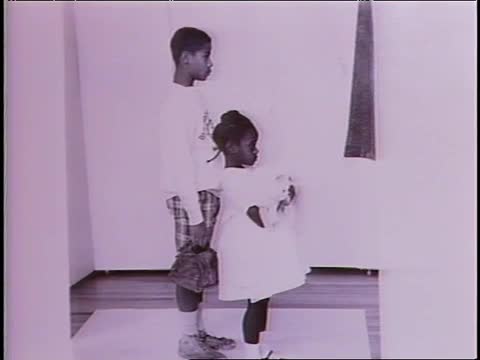Ten O'Clock News

- Transcript
I think that there is perhaps more of a message about how America view the civil rights movement and what was happening then than perhaps a message about Norman Rockwell's view of it. But what's interesting to me is if you look at the dates on these paintings there's a lag time. The New Orleans desegregation situation was 1960 the painting wasn't published until 1964. Murder in Mississippi is a year after the situation in Mississippi. And so it seems that there's a lag time too between the time when these issues are first raised and the time that they kind of made it into the mainstream consciousness she's talking about the work of artist Norman Rockwell and not necessarily his most familiar work in commemoration of Black History Month. The Rockwell Museum in Stockbridge is exhibiting his work that features blacks. The first was in 1934 he was when he was starting out. This Post magazine was going out aimed strictly at white America
middle class white America. There were never any blacks pictures and you were working in a subservient position to a very affluent white population. Or in a certain situation as you see here this Saturday Evening Post cover came in the 40s Rockwell's youngest son Peter is the model. The same thing with the boy in the dining car with the focus is on the little boy. But it's the black waiter that in many cases people are more drawn to that character. But that's the kind of situation that most of the Post readers would have encountered a black in the 40s. Not usually as their neighbors are in school with them but but in that kind of a situation. From the late 40s to the early 60s none of the Rockwell work featured people of color. But in 1964 by now working for Look magazine Rockwell like America was swept up in the turbulent 60s. One of the
collections most famous works tackles school desegregation. Mr. Arkell was very very detail oriented. And we have photographs for example showing him posing models to get them just in the pose that he wanted. But in the prom we all live with he went so far as to take numerous photographs of a wall with a crack in it so he could get that crack. Right. And the story is that his wife was very upset because he took the best tomatoes out of the garden and smashed them against the wall so he could get the smash of the tomato and the broken tomato on the ground just right. Here are advertisements. For any. Well this is when it was happening. Actual incident current. Picking up the big. And. So strong was this portrayal that Look magazine opted for a softer less
detailed study of the picture to publish the models that Rockwell used for the most part were his neighbors. In this case the only blacks in the area there was a family that lived here and in Stockbridge. And also I believe they had cousins in Great Barrington which is the next town to Stockbridge. And those children were used in the Problem We All Live With the new kids in the neighborhood as examples. Even for those painting Jews local townspeople. But what did Rockwell think about this America of the 60s. Where did he stand on questions of race. He's described as strictly apolitical simply taking his many commissioned works as they came. He really had a role as a social commentator and with what was happening in his society when he left the post in 63. He really could have started to to retire to wind down it was 69 years old. And instead he started
accepting these commissions and doing these paintings so I think that that indicates that there was some belief on his part that these were worthwhile causes. Look. Sticky situation. In
her own way. For protection against. You. Or.
Oh.
- Series
- Ten O'Clock News
- Contributing Organization
- WGBH (Boston, Massachusetts)
- AAPB ID
- cpb-aacip/15-ng4gm81z85
If you have more information about this item than what is given here, or if you have concerns about this record, we want to know! Contact us, indicating the AAPB ID (cpb-aacip/15-ng4gm81z85).
- Description
- Episode Description
- No description available
- Created Date
- 1989-02-24
- Asset type
- Raw Footage
- Genres
- News
- Topics
- News
- Rights
- Rights Note:,Rights:,Rights Credit:WGBH Educational Foundation,Rights Type:All,Rights Coverage:,Rights Holder:WGBH Educational Foundation
- Media type
- Moving Image
- Duration
- 00:11:33
- Credits
-
-
Publisher: WGBH Educational Foundation
- AAPB Contributor Holdings
-
WGBH
Identifier: 3dde9c38ec7f9b933843e267de792857e55b06e2 (ArtesiaDAM UOI_ID)
Format: video/quicktime
Color: Color
Duration: 00:00:00
If you have a copy of this asset and would like us to add it to our catalog, please contact us.
- Citations
- Chicago: “Ten O'Clock News,” 1989-02-24, WGBH, American Archive of Public Broadcasting (GBH and the Library of Congress), Boston, MA and Washington, DC, accessed August 2, 2025, http://americanarchive.org/catalog/cpb-aacip-15-ng4gm81z85.
- MLA: “Ten O'Clock News.” 1989-02-24. WGBH, American Archive of Public Broadcasting (GBH and the Library of Congress), Boston, MA and Washington, DC. Web. August 2, 2025. <http://americanarchive.org/catalog/cpb-aacip-15-ng4gm81z85>.
- APA: Ten O'Clock News. Boston, MA: WGBH, American Archive of Public Broadcasting (GBH and the Library of Congress), Boston, MA and Washington, DC. Retrieved from http://americanarchive.org/catalog/cpb-aacip-15-ng4gm81z85